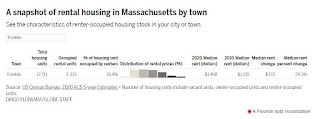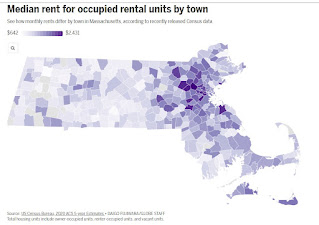| Stable fertility rates 1990-2019 mask distinct variations by age. Learn more in this America Counts story. |
|
Providing accurate and timely information about what matters in Franklin, MA since 2007. * Working in collaboration with Franklin TV and Radio (wfpr.fm) since October 2019 *
| Stable fertility rates 1990-2019 mask distinct variations by age. Learn more in this America Counts story. |
|
"Massachusetts renters ― like the state’s owners ― pay some of the highest housing costs in the nation, according to recent Census data.
Rents in Massachusetts are sixth highest among states, according to the data released last month, with the median renter paying $1,336 per month. That’s an increase from $1,006 in 2010. Lexington had the highest rental costs in the state at $2,431, followed by Brookline at $2,305, and Cambridge at $2,293.
The data, which cover a time period of 2016 to 2020, also offer a snapshot of the share of renters vs. owners. In Massachusetts overall, 33 percent of housing units were occupied by renters. Zooming into the city/town level, Chelsea has the highest share of rental housing, with 69 percent of units occupied by people who rent, followed by Lawrence at 66 percent, Somerville at 62 percent, and Cambridge at 58 percent."
 |
| table view of Franklin specific data |
 |
| Map view of Massachusetts data |
 |
| Map view of Franklin data |
The Annual Census mailing from our Town Clerk arrived in the postal mail last week and is due to be returned within 10 days.
 |
| Town of Franklin Annual Census due to be returned within 10 days of receipt |
You can put it back into the mail or drop it in the white Town business drop box at the municipal building.
 |
| You can put it back into the mail or drop it in the white business box at the municipal building |
|
 |
| The MA pay gap per Census data |
Auchincloss on New Congressional Map
"Our district has always been a powerhouse of talent, work ethic, and civic engagement. That tradition continues."
The following statement can be attributed to Congressman Jake Auchincloss in response to the release of the newly proposed Massachusetts Congressional map:
"I applaud the work of the Special Joint Committee on Redistricting and the leadership of Co-Chairs Senator Brownsberger and Representative Moran. They made certain this process was transparent and collaborative. The committee listened closely to constituents, tracked the letter and spirit of the law, and made thoughtful decisions."
"Representing a District like ours – rich in economic, geographic, and ideological diversity – gives me a valuable perspective in Washington. The new map preserves that vital diversity. The voters of the Fourth will continue to come from urban, suburban, and farmland communities. They will continue to vote both blue and red. They will continue to commute to both Boston and Providence. And they will continue to have a strong voice advocating for them in the halls of Congress during my tenure.
"Though the basic contours of the Fourth District persist, there is one major change. I am thrilled that all of Fall River will now be in the district. Through my strong partnership with Mayor Paul Coogan, Senator Mike Rodrigues, Representative Carole Fiola, Representative Paul Schmid, and Representative Alan Silvia, I have been working to ensure Fall River builds back better from the pandemic. That work will continue with full force in this Congress and beyond.
"It has been an honor to share representation of Fall River with my friend, Congressman Bill Keating, and I know he'll continue to fight for the new cities and towns he's taking on next term.
"I am excited to hit the campaign trail in the newly drawn Massachusetts Fourth this coming election cycle and I look forward to a continued partnership with state and local leaders in all of the cities and towns I represent. Our district has always been a powerhouse of talent, work ethic, and civic engagement. That tradition continues."
 |
| New Congressional Map for District 4 |
CommonWealth Magazine coverage of the proposed map
https://commonwealthmagazine.org/politics/congressional-redistricting-map-unites-fall-river/
Boston Globe coverage of the proposed map
https://www.bostonglobe.com/2021/11/01/metro/lawmakers-propose-new-congressional-maps-mass/
Today (10/27/21), the Massachusetts State Senate passed S.2560, An Act establishing senatorial districts. This bill, and the redistricting map it describes, doubles the number of majority-minority Senate districts, from three to six.
This bill divides the Commonwealth into 40 senatorial districts that will be in effect until the next redistricting cycle following the decennial census in 2030. These districts are drawn based on data from the 2020 census.
The efforts to increase majority-minority representation include the strengthening of a Black ‘ability-to-elect’ district in Boston and the creation of a Hispanic ‘ability-to-elect’ district in the Merrimack Valley, along with the creation, strengthening or preservation of four ‘opportunity-to-elect’ districts in the Chelsea area, the Brockton area, Springfield, and Boston.
The Special Joint Committee on Redistricting sought broad public input, holding. 19 public hearings, including hearings in nine different languages. The Committee also held a large number of meetings with advocates and legislators and maintained a website with case law, statistics, and ultimately, draft and final maps.
“This redistricting process will ensure that everyone's voice is heard in the Massachusetts State Senate,” said Massachusetts Senate President Karen E. Spilka (D-Ashland). ‘By listening to residents throughout this process, we have passed a map that fairly and accurately represents the people of Massachusetts. Additionally, these districts will better reflect the diversity of people who call Massachusetts home. I'd like to thank the Joint Committee on Redistricting, the members of the Senate Committee, their staffs, my Senate colleagues, and Senate Chair William Brownsberger for his thoughtful and thorough approach to ensuring equitable representation.”
“I am deeply grateful to the New Democracy Coalition, the Drawing Democracy Coalition and the hundreds of individuals who came forward to help shape the Commonwealth’s legislative districts for the coming 10 years,” stated Senator William N. Brownsberger (D-Belmont), the Senate Chair of the Joint Redistricting Committee. “I believe that with their help we have ended up with a high-quality plan.”
The Special Joint Committee on Redistricting carefully identified and sought to meet its legal obligations under the Equal Protection Clause, the Voting Rights Act, and other relevant law. It also followed traditional redistricting principals, especially emphasizing keeping municipalities whole. In a move hailed by Massachusetts municipalities, the new Senate map reduces the number of towns and cities split between two or more Senate districts from 21 to 11.
The Senate bill will now go the House of Representatives for their approval. Complete details of the Senate map can be found at malegislature.gov/redistricting.
 |
| MA Senate Passes Redistricting Legislation |
FM #646-647-648 = This is the Franklin Matters radio show, number 646-647-648 in the series.
This session shares part of the Franklin, MA Town Council meeting held on Wednesday, October 20, 2021.
The meeting was conducted in a hybrid format: members of the Town Council and Town Administration personnel, the Police retirement and promotion individuals, along with their guest and family members were in the Council Chambers, some members of the public participated in person, some via the Zoom conference bridge, all to adhere to the ‘social distancing’ requirements of this pandemic period.
I’ve split the just about two hours and forty minutes ( 2:40 total elapsed time) into three (3) logical segments:
The show notes contain links to the meeting agenda. Let’s listen to this segment of the Town Council meeting of Oct 20, 2021
--------------
Agenda document -> https://www.franklinma.gov/sites/g/files/vyhlif6896/f/agendas/october_20_2021_town_council_agenda.pdf
Agenda folder -> https://www.franklinma.gov/town-council/agenda/october-20-town-council-agenda
My notes from the meeting ->
https://www.franklinmatters.org/2021/10/recap-town-council-approves-creation-of.html
Town Council Quarterbacking session (a short recap with Council Chair Tom Mercer) ->
https://www.franklinmatters.org/2021/10/town-council-quarterbacking-with-chair.html
--------------
We are now producing this in collaboration with Franklin.TV and Franklin Public Radio (wfpr.fm) or 102.9 on the Franklin area radio dial.
This podcast is my public service effort for Franklin but we can't do it alone. We can always use your help.
How can you help?
If you can use the information that you find here, please tell your friends and neighbors
If you don't like something here, please let me know
Through this feedback loop we can continue to make improvements. I thank you for listening.
For additional information, please visit www.Franklinmatters.org or www.franklin.news
If you have questions or comments you can reach me directly at shersteve @ gmail dot com
The music for the intro and exit was provided by Michael Clark and the group "East of Shirley". The piece is titled "Ernesto, manana" c. Michael Clark & Tintype Tunes, 2008 and used with their permission.
I hope you enjoy!
------------------
You can also subscribe and listen to Franklin Matters audio on iTunes or your favorite podcast app; search in "podcasts" for "Franklin Matters"
 |
| Town Council Meeting - 10/20/21 - three audio segments |
FM #644 = This is the Franklin Matters radio show, number 644 in the series.
This shares my conversation with Town Council Chair Tom Mercer. This is one of a series of conversations meant to provide a recap of the prior Council meeting. Akin to one of the many sports post-game analysis broadcasts we are familiar with in New England, this would be a discussion focused on the Franklin Town Council meeting of October 20, 2021:
ok, what just happened?
What does it mean for Franklin residents and taxpayers?
We cover the following key topics
APPOINTMENTS - David Ogilvie: Fire Department, New Hire
PRESENTATIONS/DISCUSSIONS
American Rescue Plan Act: Jamie Hellen, Town Administrator
2020 Federal Census & Reprecincting Update: Nancy Danello, Acting Town Clerk and Kate Sjoberg, GIS Coordinator - https://www.franklinma.gov/sites/g/files/vyhlif6896/f/mai/files/10a._resolution_21-59_reprecincting.pdf and https://www.franklinma.gov/sites/g/files/vyhlif6896/f/mai/files/10a._reprecincting_maps.pdf
10b. LEGISLATION FOR ACTION - Resolution 21-60: Further Amending the Senior Citizen Property Tax Work-off Abatement Program (Motion to Approve Resolution 21-60 - Majority Vote) https://www.franklinma.gov/sites/g/files/vyhlif6896/f/mai/files/10b._resolution_21-60_senior_tax.pdf
10c. LEGISLATION FOR ACTION - Resolution 21-61: Further Amending the Veterans’ Property Tax Work-off Abatement Program (Motion to Approve Resolution 21-61 - Majority Vote) https://www.franklinma.gov/sites/g/files/vyhlif6896/f/mai/files/10c._resolution_21-61_vets.pdf
10d. LEGISLATION FOR ACTION - Resolution 21-62: Acceptance of G.L. Chapter 59, Section 5C ½ and Increase in Certain Property Tax Exemptions Pursuant Thereto (Motion to Approve Resolution 21-62 - Majority Vote) https://www.franklinma.gov/sites/g/files/vyhlif6896/f/mai/files/10d._resolution_21-62_property_tax_exemption_vets_0.pdf
The show notes include links to the meeting agenda and associated documents.
Our conversation runs about 27 minutes, so let’s listen in to my quarterbacking session with Tom Mercer. Audio file -> https://player.captivate.fm/episode/a92a0c07-06e6-419f-8329-308d8b2576f3
--------------
Agenda doc (including connection info) -> https://www.franklinma.gov/town-council/agenda/october-20-town-council-agenda
ARPA Funding Status -> https://www.franklinma.gov/sites/g/files/vyhlif6896/f/mai/files/_arpa_overview_fin_com_town_council.pdf
Census 2020 and Reprecincting presentation -> https://www.franklinma.gov/sites/g/files/vyhlif6896/f/mai/files/10a._resolution_21-59_reprecincting.pdf
Town budget info -> https://www.franklinma.gov/town-budget
School budget info -> https://www.franklinps.net/district/school-district-budget
-------------
We are now producing this in collaboration with Franklin.TV and Franklin Public Radio (wfpr.fm) or 102.9 on the Franklin area radio dial.
This podcast is my public service effort for Franklin but we can't do it alone. We can always use your help.
How can you help?
If you can use the information that you find here, please tell your friends and neighbors
If you don't like something here, please let me know
Through this feedback loop we can continue to make improvements. I thank you for listening.
For additional information, please visit Franklinmatters.org/ or www.franklin.news
If you have questions or comments you can reach me directly at shersteve @ gmail dot com
The music for the intro and exit was provided by Michael Clark and the group "East of Shirley". The piece is titled "Ernesto, manana" c. Michael Clark & Tintype Tunes, 2008 and used with their permission.
I hope you enjoy!
------------------
You can also subscribe and listen to Franklin Matters audio on iTunes or your favorite podcast app; search in "podcasts" for "Franklin Matters"
 |
| Census 2020 and Reprecincting presentation |